Vrat ki Kadhi, as the name suggests, is a special dish prepared and enjoyed during Hindu fasting days such as Navratri, Ekadashi, Maha Shivratri, Janmashtami, and other auspicious occasions. These are times when many people follow strict dietary guidelines—avoiding grains, pulses, and regular flours like wheat or gram flour (besan). Instead, they opt for naturally gluten-free and light ingredients that align with the principles of satvik food, which is pure, simple, and easy on the digestive system.
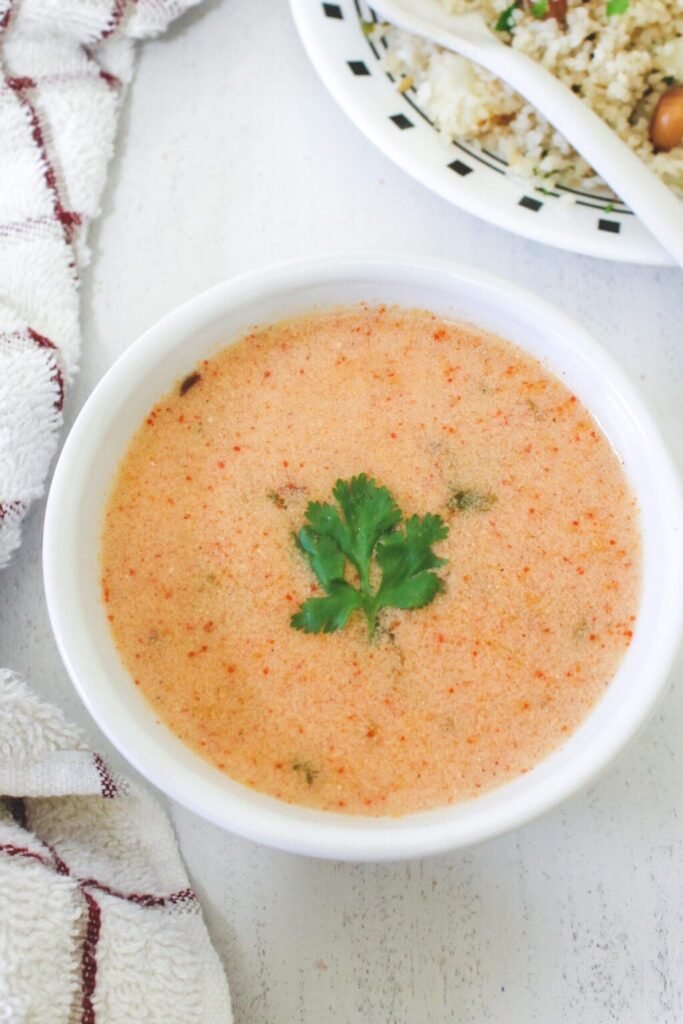
In regular kadhi, cooks typically use besan (gram flour) to thicken the spiced yogurt gravy. However, fasting guidelines prohibit besan. So, you can use Singhare ka Atta (water chestnut flour) instead. This nutrient-rich, vrat-approved flour thickens the curry beautifully and helps you prepare a smooth, mildly spiced yogurt dish known as Singhare ki Kadhi.
Singhare ka atta not only thickens the kadhi but also imparts a subtle earthy flavor that blends beautifully with the tanginess of yogurt and the gentle heat of green chilies. Cooks usually temper the dish with cumin seeds, ginger, and curry leaves, keeping it light yet flavorful—perfect for fasting days when you crave comfort without heaviness.
Traditionally served with Sama ke Chawal (barnyard millet), boiled potatoes, or even kuttu (buckwheat) rotis, Vrat Ki Kadhi is a wholesome and satisfying meal that provides nourishment and energy throughout the day. It’s a wonderful example of how fasting food can be simple yet incredibly delicious, reflecting the essence of devotion and balance.
About This Vrat Ki Kadhi Recipe
Every family follows its own unique set of customs and traditions during fasting (vrat), which often influence not just the rituals but also the ingredients allowed in meals. These traditions can vary significantly based on region, community, and even individual household beliefs. So, when preparing vrat-friendly dishes like Singhare ki Kadhi, it’s important to respect and follow the guidelines that your family observes.
You’re unsure which ingredients are allowed during fasting, ask your elders. They share their experience and guide you to prepare food that follows your family’s fasting traditions.
Many households avoid using red chili powder during fasting. If your family follows this practice, replace it with fresh green chilies to add gentle heat. Likewise, if your tradition restricts dried red chilies in tadka, simply skip them. Use cumin seeds, grated ginger, and curry leaves instead to create a flavorful and vrat-friendly kadhi.
While fasting, regular table salt is typically not used. Instead, always opt for sendha namak (rock salt) when preparing your kadhi.
Another interesting variation of this dish is the Farali Kadhi, which is made using Rajgira flour (amaranth flour) instead of singhare ka atta. Rajgira is another vrat-approved flour that is nutritious and gluten-free. It gives the kadhi a slightly nutty flavor and a different texture, yet it remains equally light and comforting. At our home, we often refer to this version simply as “Farali Kadhi,” and it pairs wonderfully with vrat ke chawal (barnyard millet) or boiled potatoes.
Ingredient Notes For Vrat Ki Kadhi:
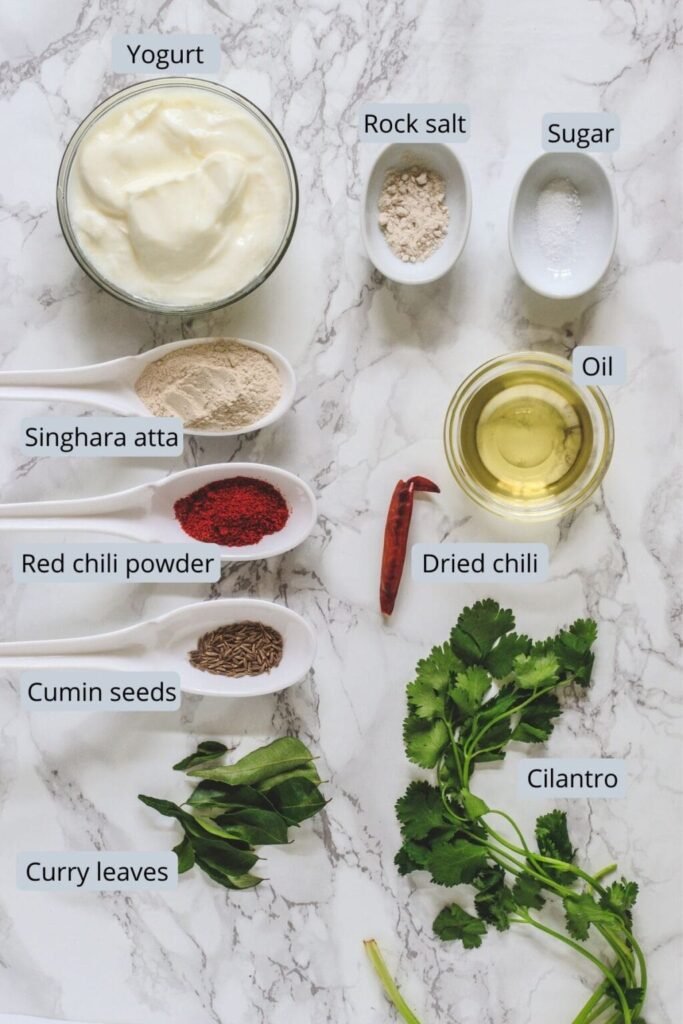
- Yogurt: Opt for full-fat yogurt made from whole milk to create a rich, creamy base that gives your kadhi a smooth and luxurious texture. It provides a rich texture and prevents the kadhi from turning watery. If you’re using low-fat or skimmed yogurt, increase the singhare ka atta (water chestnut flour) slightly to compensate and help the kadhi thicken properly.
- Singhare ka Atta (Water Chestnut Flour): This flour is a vrat-approved alternative to besan and acts as the primary thickener. Adjust the quantity depending on the thickness of your yogurt and the consistency you prefer for the kadhi.
- Peanut Oil or Ghee: For tempering, use peanut oil or ghee, both commonly allowed during fasting. Skip refined oils like sunflower or canola, as they’re not suitable for vrat.
- Sendha Namak (Rock Salt): Always use sendha namak instead of regular iodized salt, which is restricted during Hindu fasts. It imparts a pure, mineral-rich taste that complements the fasting-friendly flavors.
- Sugar: A tiny pinch of sugar can be added to mellow out the tanginess of yogurt and give a gentle balance to the overall flavor.
- Green Chilies / Red Chili Powder: If your family tradition doesn’t permit red chili powder during vrat, finely chop and use green chilies to add the desired heat. Customize the spice level as per individual fasting rules.
- Cumin Seeds & Curry Leaves: These are sautéed in ghee or oil to release their aroma and add depth to the kadhi’s flavor.
- Dried Red Chili: Include only if allowed in your fasting guidelines—it adds a smoky heat to the tempering.
- Cilantro (Coriander Leaves): Finish the dish with a sprinkle of fresh chopped coriander for added freshness and color.
How To Make Vrat Ki Kadhi For Navratri?
1) Combine the base ingredients:
In a large mixing bowl, combine full-fat yogurt with singhare ka atta (water chestnut flour), sendha namak (rock salt), a small pinch of red chili powder (only if permitted for fasting), and a little sugar to gently offset the yogurt’s natural tanginess. Mix well to form a smooth, lump-free base. This combination forms the flavorful base of your vrat-special kadhi.
2) Whisk to perfection:
Whisk the mixture vigorously until the yogurt turns smooth and creamy, ensuring the singhare ka atta is completely dissolved without any lumps. This step is crucial for achieving a velvety, lump-free consistency in the finished kadhi.
3) Add water and blend again:
Gradually pour in water while continuing to whisk. This helps loosen the mixture to a pourable consistency and prevents any flour lumps. The result should be a homogeneous, smooth batter with a slightly runny texture suitable for simmering.
4) Cook the kadhi mixture:
Pour the prepared mixture into a thick-bottomed saucepan or a traditional patila. Turn the flame to medium and begin cooking. Stir continuously with a whisk or wooden spoon to maintain a steady texture and prevent the yogurt from splitting or curdling as it heats. Consistent stirring ensures even cooking and a smooth, homogenous kadhi. As the mixture heats, it will slowly start to bubble. Allow it to simmer for about 5–8 minutes or until it thickens to your desired consistency. The kadhi should have a velvety and slightly glossy finish.
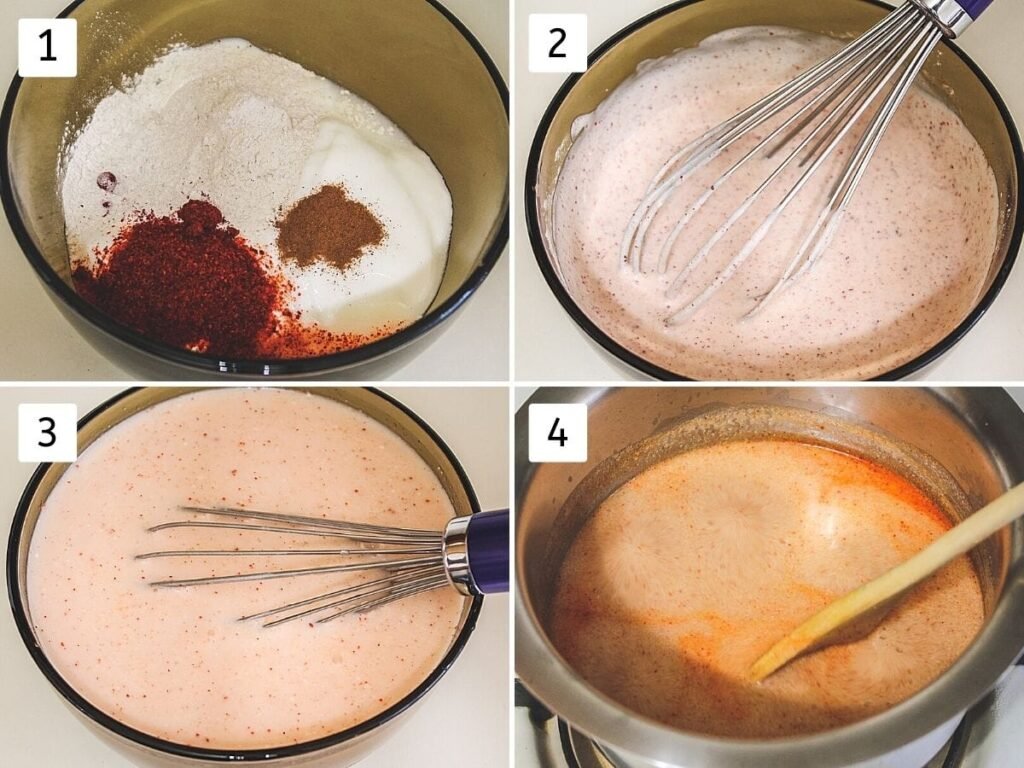
5) Prepare the tempering (tadka):
As the kadhi simmers gently, heat a vrat-friendly fat like peanut oil or ghee in a small tadka pan over medium flame. These options are ideal for fasting and impart a rich aroma to the tempering. Once the oil is hot, add cumin seeds. Let them sizzle and release their earthy aroma, signaling that the oil is well-infused.
6) Add spices to the tadka:
Add dried red chili (if allowed during fasting) and fresh curry leaves to the hot oil. Be cautious, as the curry leaves may splutter. Sauté for 30–40 seconds until the spices are aromatic and slightly crisped, infusing the ghee with rich flavor.
7) Combine the tadka with the kadhi:
Immediately pour the hot tempering into the simmering kadhi. You’ll hear a satisfying sizzle as the flavors fuse together. Stir gently so the tempering is evenly distributed throughout the kadhi.
8) Garnish and serve:
Turn off the heat and sprinkle freshly chopped coriander (cilantro) over the top for a burst of freshness and color. Serve hot with samak rice (barnyard millet), vrat-friendly parathas, or boiled potatoes for a wholesome, comforting fasting meal.
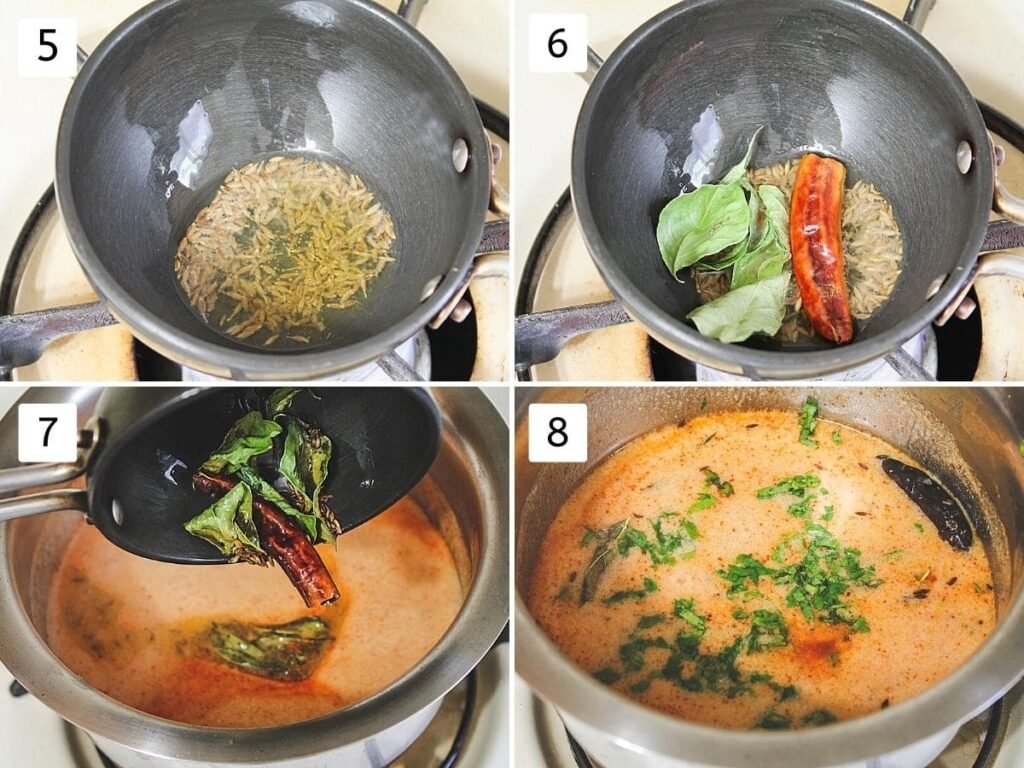
Expert Tips:
1) Adjusting flour quantity based on yogurt type:
If you’re preparing vrat ki kadhi with low-fat or fat-free yogurt, consider adding a little more singhare ka atta (water chestnut flour). Since low-fat yogurt lacks the natural richness of full-fat yogurt, the extra flour helps to thicken the kadhi and maintain a desirable consistency. Without this adjustment, the kadhi may turn out runny or less satisfying in texture.
2) Use sour yogurt for the best flavor:
Traditional kadhi tastes best when made with naturally sour yogurt. That subtle tang brings out a richer flavor profile and adds a touch of traditional authenticity to the kadhi. If your yogurt isn’t naturally sour, don’t worry—there’s a simple workaround.
3) Add lemon juice if needed:
If your yogurt tastes mild or sweet, stir in a few drops of fresh lemon or lime juice toward the end of the cooking process. This adds the desired acidity and lifts the flavor profile, bringing it closer to a classic kadhi.
4) How to make yogurt sour at home:
To naturally sour your yogurt, take the required quantity and place it in a covered bowl. Leave it at room temperature (on the kitchen counter) for about 4–5 hours. The exact timing depends on your local climate.
In warmer weather, the yogurt may sour within 1.5 to 2 hours.
In cooler temperatures, it may take up to 6–8 hours.
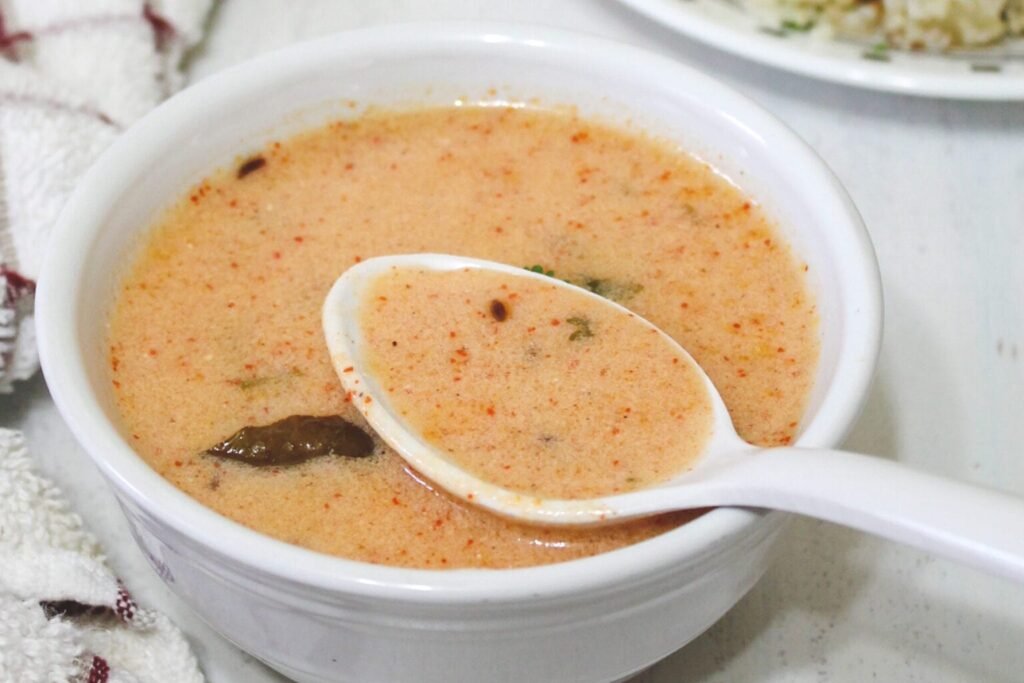
Serving Ideas For Vrat Ki Kadhi
- With Sama Khichdi or Sabudana Khichdi: Vrat ki kadhi makes a delicious and comforting combination when served with sama rice khichdi (also known as barnyard millet khichdi) or sabudana khichdi (stir-fried tapioca pearls). The light, fluffy texture of sama khichdi complements the mildly spiced kadhi, making it a satisfying and wholesome meal during fasting days. Sabudana khichdi, with its slightly chewy texture and rich flavors from peanuts and spices, also makes an excellent companion to this soothing yogurt-based kadhi.
- With Vrat-Friendly Flatbreads: If you prefer rotis or puris during fasting, this kadhi goes equally well with a variety of vrat-approved breads. Try it with rajgira paratha (amaranth flour flatbread), kuttu paratha (buckwheat flour flatbread), or singhare ki puri (deep-fried water chestnut flour bread). These breads soak up the kadhi beautifully, offering a comforting, hearty bite with every mouthful.
- Alternative Combinations: You can also serve vrat ki kadhi with farali puri, a lightly spiced, deep-fried puri made with fasting flours. Some people also enjoy this kadhi with boiled sweet potatoes or steamed arbi (taro root) as part of their fasting platter.
- Finishing Touches: Add a wedge of lemon or a few slices of cucumber on the side for freshness. Serve the kadhi hot with a sprinkle of fresh coriander for aroma and a complete fasting meal that is both nutritious and deeply satisfying.
